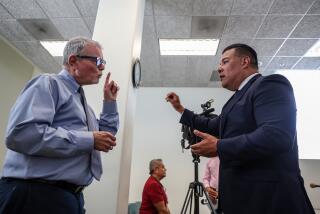Rinks Are Skating on Thin Ice : Spiraling Insurance Premiums Worry Operators
- Share via
The widespread shortage and escalating cost of liability insurance has one industry skating on particularly thin ice. This time the chill is being felt by operators of local ice skating rinks who can’t afford skyrocketing premiums or even find insurers.
As a result some Southern California rinks are operating without insurance or closing their doors--and indications are that the local situation is shared by ice rinks nationwide.
Nationwide Crisis
According to Justine Smith of the Ice Skating Institute of America, a rink in Baltimore had to close because of a lack of insurance. In Northern California, a rink owned by Peanuts creator Charles Schulz in Santa Rosa closed for a short time last November after the rink’s liability coverage was canceled. The rink reopened, but with an annual liability insurance premium of $150,000, 10 times what it had cost the year before.
According to Mike Wakely, a Tustin insurance agent, three or four local rinks are currently operating without insurance. He declined to name them, stating, “They’re nervous enough as it is.” “Very clearly we have an insurance crisis and it is hurting the small businessman,” said Bruce Bunner, California state insurance commissioner.
He said his office “is aware of the problem” ice rink operators are having with liability insurance, but said their situation is shared to some extent by all businesses.
Small, specialized businesses such as ice rinks are often passed over by the large underwriters, he said. “It’s not a very large premium to the (large) companies. Quite often these kinds of risks are underwritten by speciality companies.”
Because of widespread losses in the insurance industry (a record operating loss of $5.5 billion was reported in 1985), a number of small specialty companies have folded, he said, while those still in existence are careful about whom they insure. “Any one claim can outstrip all of the premiums,” Bunner added.
Rinks Vulnerable
The insurance hikes have come at a time when ice rink operators are especially vulnerable, said Michael Paikin, managing partner of Van Nuys Iceland and the Pasadena Ice Skating Center. “The ice skating industry runs on four-year cycles that run with the Olympics. We’re in the low end of it.”
(The Ice Skating Institute of America reports that nearly 30 million Americans are recreational ice skaters, a figure that has held steady in recent years.)
Paikin’s Pasadena rink closed for a week in early December because the city, which owns the building, would not permit the rink to operate without insurance, he said. The Van Nuys location, faced with no such requirement, did not close but has been operating without insurance since Dec. 7.
Darius Mavjzoub, owner of the Norwalk Ice Arena, said his rink has been operating without insurance since Oct. 25, when his policy was canceled 10 days before it was due to expire. Paikin, who did find coverage for the Pasadena rink, said his annual premium increased from $7,500 to $43,000 while his coverage dropped from $1 million to $300,000. His deductible went from $250 to $1,000, he noted.
Hockey Discouraged
What’s more, Paikin said every insurance company he talked to sought to lessen its liability for personal injury claims by insisting on one exemption from coverage--hockey leagues. “I can’t afford to get rid of hockey,” he said.
Mavjzoub, who paid $3,600 for $1 million of coverage in November, 1984, recently was quoted a premium of $38,800 for $300,000 coverage, he said. The policy excluded not only hockey players, but figure skaters, spectators and pollution that could be caused by the cooling system as well.
Mike Wakely, one of the few insurance agents in the state who continues to sell policies to ice skating rinks, said it has become increasingly difficult to find underwriters to carry such policies.
He said that most rink operators will not have to worry about losing their hockey leagues in the short term, because the leagues generally have their own insurance.
But there may be bad news for hockey leagues in the near future, the Tustin insurance agent said, predicting that they too will face insurance price hikes.
Part of the problem is that companies are worried about insuring rinks where people go expecting to trip and fall, Wakely said. Claims against ice skating rinks are generally not of the blockbuster variety, he said. “The largest I’ve seen was $12,000, which is not that bad.”
Insurance Investments Blamed
Perhaps more significant, he said, is that insurance companies have redoubled their efforts to make an “underwriting profit.” Only part of the insurance business involves collecting premiums and paying claims; investment of premiums is also a major part, he explained.
Such new realities have made insurance companies more cautious about what kinds of policies they write, Wakely said. “If it’s in any way out of the ordinary, they often just don’t want anything to do with it.”
Another problem is that some insurance companies are skittish about covering child-related businesses, a reality that has hit the day-care industry hard.
Don Bartelson, owner of the Ontario Ice Skating Center, said his facility generated four claims last year. “They are all small, $500, $700 type of things,” he said.
Bartelson said he learned five days before his policy was due to expire that it would not be renewed. When he did find an insurer, he was offered only 30% of his previous coverage ($300,000 versus $1 million) at six times the price ($36,000 versus $6,000).
Rate Increase Inadequate
One recourse for rink operators is to increase rates. Admission to Bartelson’s arena went from $3 to $3.50 on Jan. 1. But “no way” would the price increase offset the increase in insurance costs, he said.
Roberta Moon, owner-manager of the West Covina Ice Skating Arena, said it is unrealistic to pass all increased operating costs on to the customer. “You reach a point of diminishing returns,” she said. “You can’t raise your rates appreciably. It’s like you can have 100 people at $5 or 70 people at $7.”
In 1983, Moon said she paid about $5,000 in premiums for $5-million of coverage; last year, she paid $9,300 for $300,000 of coverage.
This year, after “calling all over the state,” she said she received two offers; one provided $300,000 of coverage for $43,000.
“We don’t have even that much (in) held earnings,” she said. “We had to settle for $100,000 (of coverage) for about $9,000.”
She terms such coverage inadequate. “That’s woefully low for any place with a need for liability insurance,” she said.
Sign First, Then Skate
To discourage liability claims, rink operators in the last year have been asking patrons to sign “hold harmless forms,” Moon said. “We tell them all the things that could possibly be dangerous.” But such forms, she noted, are not likely to discourage a person determined to sue.
Moon said increases in energy costs in the 1970s substantially raised the cost of operating ice rinks. She estimates her annual electricity bill at $90,000 to $100,000.
Paikin said ice rinks in Woodland Hills, Santa Monica, Anaheim, San Diego and Lancaster have gone out of business in recent years, mostly because of increased energy costs.
Richard Zamboni has a surname that is synonymous with ice skating. His father, Frank, invented the ice-resurfacing machine that is now standard equipment at rinks and built the Iceland rink in Paramount in 1939.
Richard Zamboni fears for the future of the ice skating industry and the Paramount Ice Rink, which has been operating without insurance since mid-January.
“I’m afraid that it’s going to make it just that much more difficult to stay open,” said Zamboni, who is treasurer of the Ice Skating Institute of America. “And we don’t need that after the explosion of energy prices. I don’t know what the future is going to hold.”


